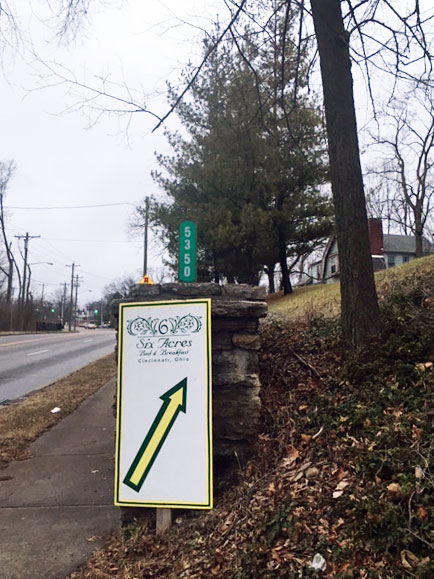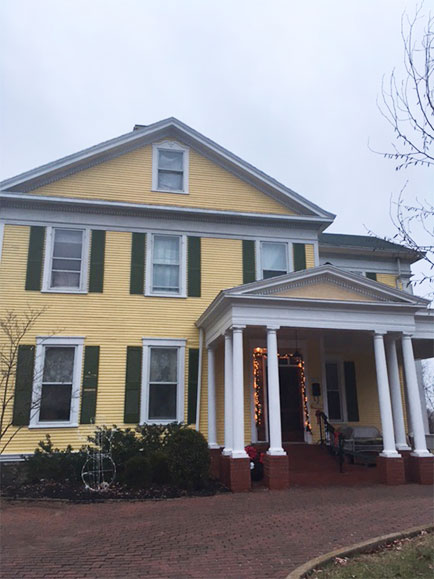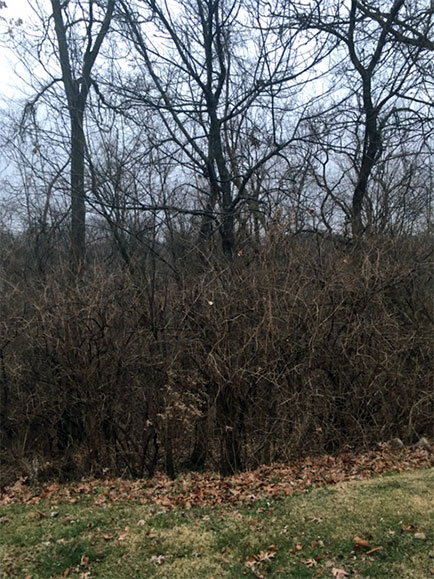The Ghosts of Six Acres, an African-American Owned Underground Railroad House
I am often on the prowl for historically interesting houses. This past December, when I returned to my hometown of Cincinnati, Ohio for the winter break, I got the unexpected chance to tour a special house. Two people from very different parts of my life happened to mention the home to me within the space of 48 hours. They were Chris Momany, Chaplain at Adrian College in Southeastern Michigan, who is dedicated to preserving the history of abolitionism at his institution and in the region, and Anne Steinert, an elementary school friend and historic preservationist who is currently a doctoral student in History at the University of Cincinnati. Chris told me that students from Adrian College had taken a memorable field trip to Cincinnati to stay in a home that operated as part of the Underground Railroad. Anne told me that a woman in the city had purchased and restored a documented UGRR home and turned it into a successful B & B. The site, called Six Acres Bed and Breakfast, is located in the College Hill neighborhood (formerly Pleasant Hill) fifteen minutes outside of downtown Cincinnati. A second old house on the property, Seventh Acre, also has guest rooms. The property includes landscaped lawns, a wooded area that dips into a deep ravine, and broad views.
Two mentions of the same house seemed like a rather forceful prompt, so I  set out spontaneously one day to find the place, dragging my husband, a cultural psychologist, along. Chelli Kitchen, the B & B’s only resident employee and sister of the owner, Kristin Kitchen, welcomed us in and offered an informative, story-filled tour. The chronicle of how her sister came to own the house was dramatic. According to Chelli, Kristin first entered the house as a high school student attending a graduation party when the home was in private hands. She returned the next day to recover lost keys, found a moment of peace as she gazed down on a wooded ravine and creek below the yard, and determined that she would own the place one day. Years later, the house declined after a developer bought the land, was refused the right to tear down the structure due to its historical significance, and then left it to rot. Kristin rediscovered the condemned building and snuck inside. A professional by then with degrees in marketing and African American studies, she launched what became a long struggle to purchase the house. Kristin slowly restored the home, replacing and renovating what she could and years later, purchasing a second abode that had formerly been part of the parcel. The sisters now operate the home as a Bed & Breakfast that highlights the site’s history. Six Acres was built between 1850 and 1860 by a Cincinnati Quaker and farmer, Zebulon Strong. Strong, who originally had 50 acres on the hill, used a false bottom wagon to assist people seeking freedom who approached his house via the Mill Creek. The property is located on Hamilton Avenue, also U.S. Route 127, which continues north through Ohio and into Michigan; Michigan abuts Ontario, Canada at the Detroit River.
set out spontaneously one day to find the place, dragging my husband, a cultural psychologist, along. Chelli Kitchen, the B & B’s only resident employee and sister of the owner, Kristin Kitchen, welcomed us in and offered an informative, story-filled tour. The chronicle of how her sister came to own the house was dramatic. According to Chelli, Kristin first entered the house as a high school student attending a graduation party when the home was in private hands. She returned the next day to recover lost keys, found a moment of peace as she gazed down on a wooded ravine and creek below the yard, and determined that she would own the place one day. Years later, the house declined after a developer bought the land, was refused the right to tear down the structure due to its historical significance, and then left it to rot. Kristin rediscovered the condemned building and snuck inside. A professional by then with degrees in marketing and African American studies, she launched what became a long struggle to purchase the house. Kristin slowly restored the home, replacing and renovating what she could and years later, purchasing a second abode that had formerly been part of the parcel. The sisters now operate the home as a Bed & Breakfast that highlights the site’s history. Six Acres was built between 1850 and 1860 by a Cincinnati Quaker and farmer, Zebulon Strong. Strong, who originally had 50 acres on the hill, used a false bottom wagon to assist people seeking freedom who approached his house via the Mill Creek. The property is located on Hamilton Avenue, also U.S. Route 127, which continues north through Ohio and into Michigan; Michigan abuts Ontario, Canada at the Detroit River.
The main house at Six Acres is cozy and charming, sporting a sunny coat of buttercup yellow paint that Kristin chose at the time of the renovation. There is a feeling of warmth and welcome in the house created by its host, Chelli, and also by a sense of the activist purposes its capacious rooms were once assigned to. While we were all sitting comfortably in the parlor conversing about the history of the house, Chelli’s eyes focused away from me and my husband, through the wide front hallway, and toward the entry door.
of buttercup yellow paint that Kristin chose at the time of the renovation. There is a feeling of warmth and welcome in the house created by its host, Chelli, and also by a sense of the activist purposes its capacious rooms were once assigned to. While we were all sitting comfortably in the parlor conversing about the history of the house, Chelli’s eyes focused away from me and my husband, through the wide front hallway, and toward the entry door.
“Do you see that shadow?” she asked. She kept her eyes on the spot, as if trying to piece together a puzzle. “It wasn’t there before. I’m trying to figure out where it’s coming from. It’s moving.”
My husband asked her, then, with a bit of subdued humor in his voice, “Do you have ghosts here?”
Chelli replied that they do have ghosts, whom she called “the ancestors.”
If you know that I recently published a history that analyzes ghost tourism at southern sites of slavery, you can guess that I listened quite closely to what followed. Throughout my research in Savannah, Charleston and Louisiana for the book Tales from the Haunted South, I had not met an African American site owner or manager who foregrounded stories of hauntings. In fact, I argued that black people in those areas famous for being haunted seemed to avoid the business of ghosts and instead to respect the dead through the care and preservation of grave sites.
Chelli told us that there was one ghost whom several visitors have seen. I asked what the ghost looked like. Chelli responded, “Have you seen her?” I had not, so Chelli described the figure as a black woman in Quaker garb who had probably been a servant. She also described a formerly enslaved woman who told one of the guests her name was Grace, a boy who had entered the home via the UGRR and died in the African healing circle carved into the floorboards in an attic room, and a “cantankerous” white man who crashes about making noises but whom Grace keeps in check. Chelli willingly offered these stories in the same engaged and even tone with which she had recounted the documented history of the house.
I will admit that I felt a heightened awareness as Chelli shared these sightings of spirits with us. This is because when she had pointed out the shadow twenty minutes prior, I had followed the direction of her gaze. I saw the shadow too, a faint dark shape against the wall that shifted slightly as if someone were moving in and out of the light just beyond our field of vision. There were no other guests at the B & B that day. The house was empty save for us three. I stared at the shadow, trying to locate the source and never found one. I will not call it a ghost, no matter where my imagination might lead me. But I will say, and this is the most important bit, that the proprietors of this B&B do not offer ghost tours. They do not even allow visitors to enter the upper chamber where they believe people escaping from slavery hid and performed rituals of healing. These are the stories and places about “the ancestors,” as Chelli put it, that the site owners seek to protect rather than commercialize.
Read accounts of the Adrian College students’ experience hiking the ravine on an UGRR route and a post by Chris Momany on the Historians Against Slavery blog.
Watch Kristin Kitchen discuss the history of the site and the house she calls “magic.”
Six Acres has received multiple stars and excellent reviews on travel and food sites. Learn more about Six Acres Bed & Breakfast.
2 Comments
Dr. Christopher P. Momany
Tiya: I am so sorry that I am just now catching up to this piece. Thank you for the “shout-out.” I will share with the students.
Dr. Sarah E. Shumate, Retired University Admininstrator and Social Studies Teacher
Tiya:
As a 1970 graduate of Adrian College in History, I am excited to leave or your example of “Exploring, Dreaming and Discovering” long forgotten history of our people through the abolitionist period. Adrian College is blessed to have a Chaplain like Rev. Dr. Christopher Momany on our staff inspiring, guiding and teaching our students not only the reality of experience from this important period in our history, but also connecting it to the 21st Century. As a member of the Board of Trustees, I am always delighted to see and hear of his continuing efforts to enhance diversity and connectedness among people. Although I live in South Florida, my heart remains in the Midwest having come from Northeastern Ohio-Hudson, Ohio- another stop of the underground railroad to freedom. God bless you and your work. I am especially proud of our Adrian College Students as well.